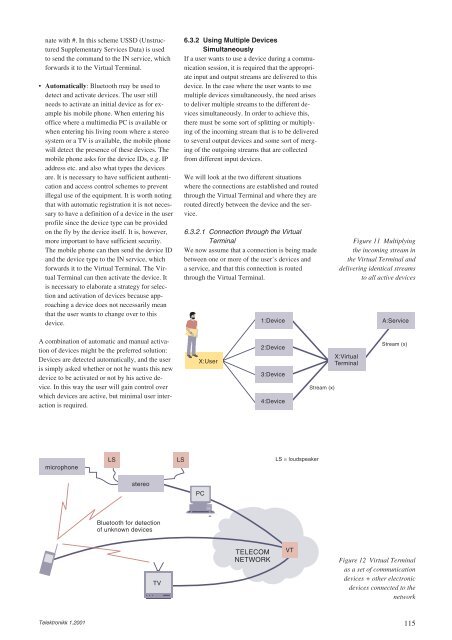You also want an ePaper? Increase the reach of your titles
YUMPU automatically turns print PDFs into web optimized ePapers that Google loves.
nate with #. In this scheme USSD (Unstructured<br />
Supplementary Services Data) is used<br />
to send the command to the IN service, which<br />
forwards it to the Virtual Terminal.<br />
• Automatically: Bluetooth may be used to<br />
detect and activate devices. The user still<br />
needs to activate an initial device as for example<br />
his mobile phone. When entering his<br />
office where a multimedia PC is available or<br />
when entering his living room where a stereo<br />
system or a TV is available, the mobile phone<br />
will detect the presence of these devices. The<br />
mobile phone asks for the device IDs, e.g. IP<br />
address etc. and also what types the devices<br />
are. It is necessary to have sufficient authentication<br />
and access control schemes to prevent<br />
illegal use of the equipment. It is worth noting<br />
that with automatic registration it is not necessary<br />
to have a definition of a device in the user<br />
profile since the device type can be provided<br />
on the fly by the device itself. It is, however,<br />
more important to have sufficient security.<br />
The mobile phone can then send the device ID<br />
and the device type to the IN service, which<br />
forwards it to the Virtual Terminal. The Virtual<br />
Terminal can then activate the device. It<br />
is necessary to elaborate a strategy for selection<br />
and activation of devices because approaching<br />
a device does not necessarily mean<br />
that the user wants to change over to this<br />
device.<br />
A combination of automatic and manual activation<br />
of devices might be the preferred solution:<br />
Devices are detected automatically, and the user<br />
is simply asked whether or not he wants this new<br />
device to be activated or not by his active device.<br />
In this way the user will gain control over<br />
which devices are active, but minimal user interaction<br />
is required.<br />
microphone<br />
Telektronikk 1.2001<br />
LS<br />
stereo<br />
Bluetooth for detection<br />
of unknown devices<br />
TV<br />
LS<br />
6.3.2 Using Multiple Devices<br />
Simultaneously<br />
If a user wants to use a device during a communication<br />
session, it is required that the appropriate<br />
input and output streams are delivered to this<br />
device. In the case where the user wants to use<br />
multiple devices simultaneously, the need arises<br />
to deliver multiple streams to the different devices<br />
simultaneously. In order to achieve this,<br />
there must be some sort of splitting or multiplying<br />
of the incoming stream that is to be delivered<br />
to several output devices and some sort of merging<br />
of the outgoing streams that are collected<br />
from different input devices.<br />
We will look at the two different situations<br />
where the connections are established and routed<br />
through the Virtual Terminal and where they are<br />
routed directly between the device and the service.<br />
6.3.2.1 Connection through the Virtual<br />
Terminal<br />
We now assume that a connection is being made<br />
between one or more of the user’s devices and<br />
a service, and that this connection is routed<br />
through the Virtual Terminal.<br />
X:User<br />
PC<br />
TELECOM<br />
NETWORK<br />
1:Device<br />
2:Device<br />
3:Device<br />
4:Device<br />
LS = loudspeaker<br />
VT<br />
Stream (x)<br />
Figure 11 Multiplying<br />
the incoming stream in<br />
the Virtual Terminal and<br />
delivering identical streams<br />
to all active devices<br />
X:Virtual<br />
Terminal<br />
A:Service<br />
Stream (x)<br />
Figure 12 Virtual Terminal<br />
as a set of communication<br />
devices + other electronic<br />
devices connected to the<br />
network<br />
115

















